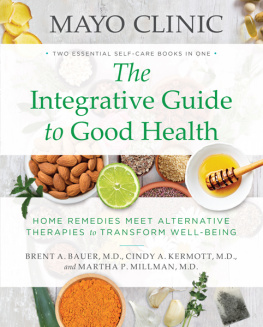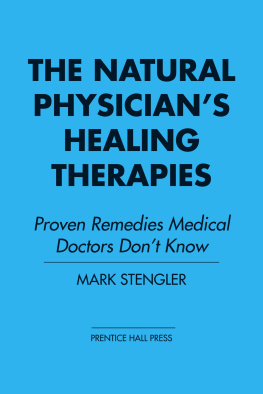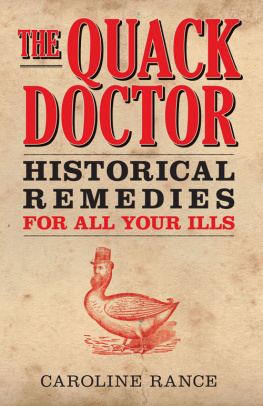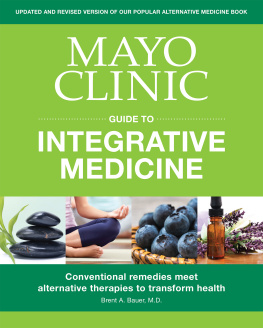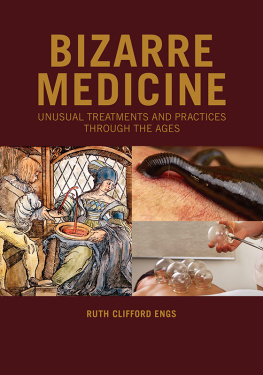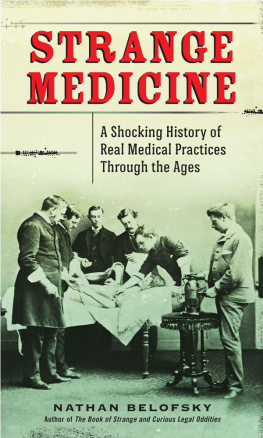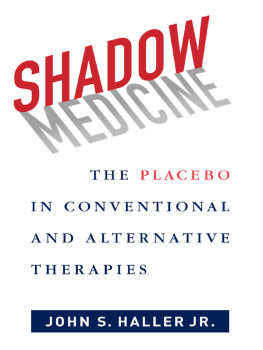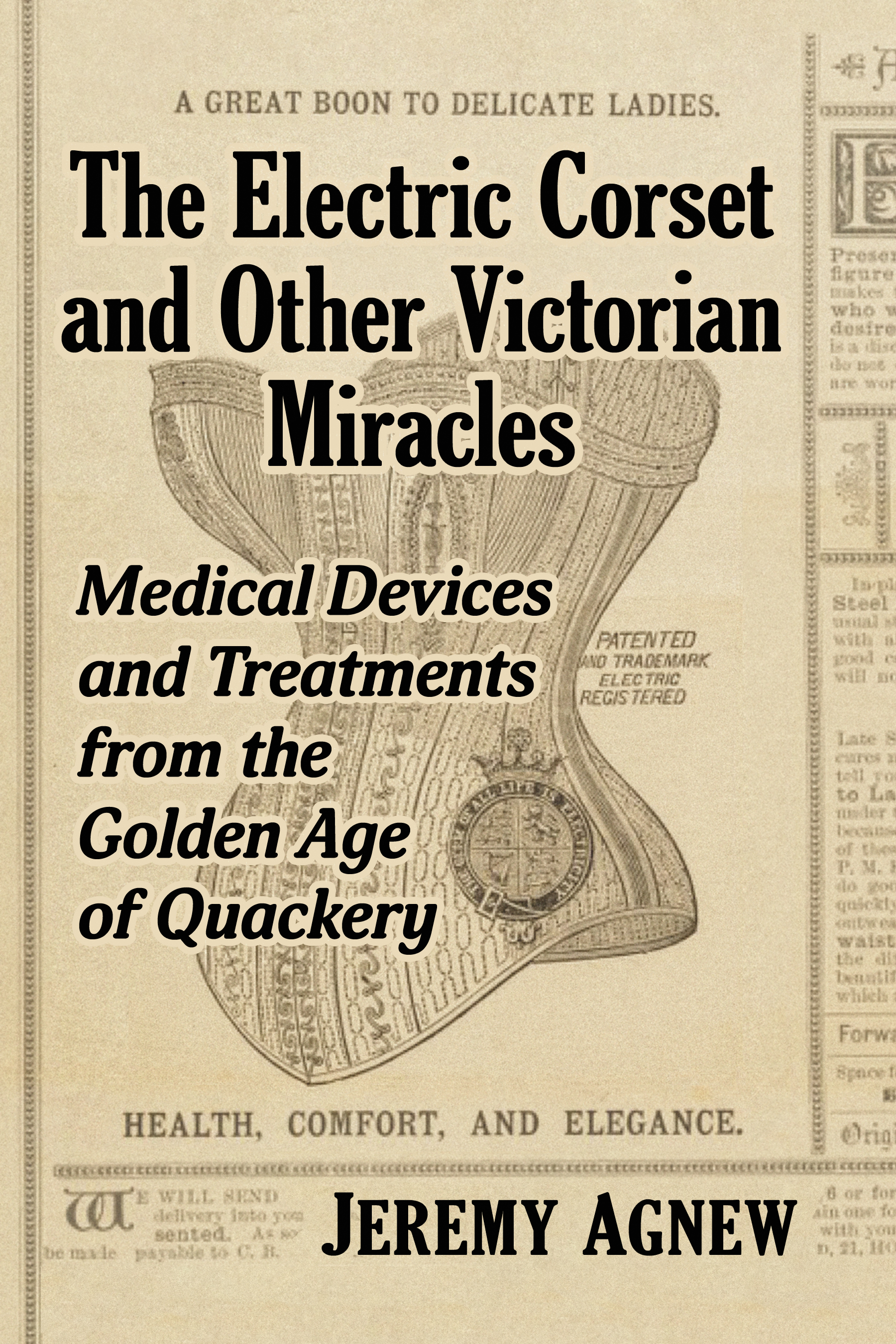The Electric Corset and Other Victorian Miracles
Also by Jeremy Agnew and from McFarland
The Landscapes of Western Movies: A History of Filming on Location, 19001970 (2020)
Healing Waters: A History of Victorian Spas (2019)
The Age of Dimes and Pulps: A History of Sensationalist Literature, 18301960 (2018)
Crime, Justice and Retribution in the American West, 18501900 (2017)
Spanish Influence on the Old Southwest: A Collision of Cultures (2016)
The Creation of the Cowboy Hero: Fiction, Film and Fact (2015)
Alcohol and Opium in the Old West: Use, Abuse and Influence (2014)
The Old West in Fact and Film: History Versus Hollywood (2012)
Entertainment in the Old West: Theater, Music, Circuses, Medicine Shows, Prizefighting and Other Popular Amusements (2011)
Medicine in the Old West: A History, 18501900 (2010)
The Electric Corset and Other Victorian Miracles
Medical Devices and Treatments from the Golden Age of Quackery
Jeremy Agnew


Jefferson, North Carolina
ISBN (print) 9781-476683836
ISBN (ebook) 9781-476645261
Library of Congress and British Library cataloguing data are available
2021 Jeremy Agnew. All rights reserved
No part of this book may be reproduced or transmitted in any form or by any means, electronic or mechanical, including photocopying or recording, or by any information storage and retrieval system, without permission in writing from the publisher.
Front cover image: Advertising leaflet. The corset was recommended for all ladies suffering from any bodily ailment ... they perform astonishing cures and invigorate every part of the system, London, Pall Mall Electric Association, 1882, The Pall Mall Electric Association, Limited, 21, Holborn Viaduct, London, E.C. (Welcome Collection)
Printed in the United States of America
Exposit is an imprint of McFarland & Company, Inc., Publishers


Box 611, Jefferson, North Carolina 28640
www.expositbooks.com
For Steve,
my business partner a long time ago,
who inadvertently involved us
in the world of medical humbug
Table of Contents
Preface
The practice of medicine is based on the prevention of disease, and the art and science of healing. The field of medicine has undergone constant change over the past two thousand years as new theories and techniques have been brought to bear on illness, thus medicine has been influenced by the particular culture, time, and place in which it has been practiced.
Treating the sick and injured has been a part of medicine since before recorded history, and devices to assist in treatment gradually evolved as a part of medical practice. Some of the first medical devices were amulets and talismans used by the earliest healers to assist them in the treatment process. Later, Roman and Greek physicians developed various medical instruments and appliances to support their healing efforts. Specialized knives, for example, were developed for use in their primitive surgery, needles and thread were used for closing wounds, and forceps were improved to assist with treating injuries and performing operations. Specialized drills were developed for cutting holes in the skull to treat brain injuries and headaches and, with misguided zeal, in an attempt to allow evil spirits that were thought to cause madness to escape from the inside of the head. Foreshadowing modern physical therapy, the Greek physician Galen developed a technique for treating disorders of the spine with a device that stretched the patient out flat on an apparatus with pulleys and ropes attached to the arms and legs, even though its use looked somewhat like a rack used for medieval torture.
Gradually, scientific medical instruments and devices were developed to assist in the diagnostic process, including various types of speculums to allow internal visualization of body cavities, the stethoscope to listen to sounds of the heart, and the ophthalmoscope to diagnose the condition of blood vessels at the back of a patients eye.
Scientific advances during the age of enlightenment included new developments in medicine and a better understanding of the human body. However, as the 1800s dawned, patients started to realize that the standard methods of bleeding and purging that had been the primary methods of treatment for hundreds of years were not generally effective and were certainly unpleasant. The public was ready for less invasive, less painful, alternative methods of healing. Even established physicians started to question the effectiveness of the old methods.
The early Victorian era of the mid1800s saw the rise of various alternative medical movements, such as homeopathy, naturopathy, hydropathy, Thomsonian medicine, phrenology, mesmerism, and spiritualism. The time was right for these healers who promoted themselves and their treatments as painless and easy. Each of the new methods was a break from the traditional medicine of the time and each claimed to use more natural methods of healing. But along with the legitimate healers came medical quacks who capitalized on the realization that many of the Americans who wanted inexpensive, painless, easy-to-use cures for use in the privacy of their own homes could be a golden source of revenue.
The last half of the nineteenth century and the first few decades of the twentieth form a fascinating, yet somewhat perplexing, time in the history of medicine. This period formed the transition between ancient and modern medicine, between the antiquated treatments of bleeding and purging, and advances in better understanding disease processes and causes, and various medical treatments that formed the basis for moving into the modern age of scientific medicine.
As new scientific phenomena emerged in the 1800s to help explain the world around us, new forms of energy were discovered. One result was that these new discoveries, including electricity, magnetism, X-rays, and radioactivity, were quickly applied to the healing arts.
These mysterious unseen forces of radiant energy were quickly theorized to relate to the basic energy of the body itself. Radiant energy, which travels via wave motion, extends over a wide spectrum of frequencies. At the low end of the energy spectrum are sound waves that are audible to the human ear. At the upper end are cosmic rays that travel to (and through) our bodies from outer space. In between are other types of energy, including the visible spectrum of light that we observe with our eyes and X-rays that are powerful enough to penetrate the human body. By the end of the nineteenth century and early in the twentieth, different types of energy from across the spectrum were being applied to the human body in the hopes of finding new ways to treat and cure illness. An appendix at the back of this book outlines the radiant energy spectrum in ascending order of frequency to help place these forms of energy in perspective.


